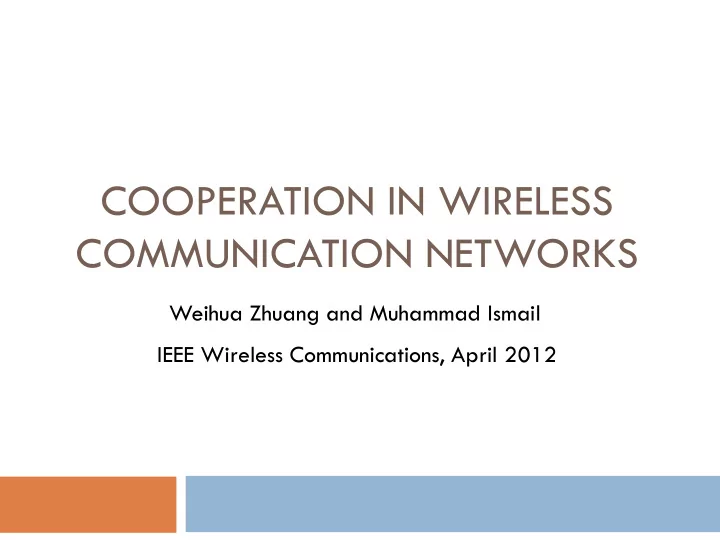

COOPERATION IN WIRELESS COMMUNICATION NETWORKS Weihua Zhuang and Muhammad Ismail IEEE Wireless Communications, April 2012
Outline 2 Introduction Potential Benefits Challenging Issues at Different Protocol Layers Future Directions Conclusion
Introduction 3 Cooperation: - The process of working together - Social science & Economics Wireless communications User mobility support Limited resources Cooperation Scenarios Improve channel Improve throughput Achieve seamless reliability through through resource service provision spatial diversity aggregation
Introduction Cont. 4 - Modifications to the networking protocol - Questions: What are potential benefits of cooperation in wireless communication networks? What are challenging issues that arise at different layers of the protocol stack to support cooperation and how can we handle them? What are open research issues?
Outline 5 Introduction Potential Benefits Challenging Issues at Different Protocol Layers Future Directions Conclusion
Potential Benefits 6 Improved Channel Reliability 1 Mitigating Channel Interference Reduction Impairments Txion power reduction Solving hidden terminal Spatial Diversity
Potential Benefits Cont. 7 2 Improved System Throughput 3 Seamless Service Provision Resource Aggregation Substitute Path Operation Cost Reduction 4 Improved Energy Network Coverage Efficiency Extension
Outline 8 Introduction Potential Benefits Challenging Issues at Different Protocol Layers Future Directions Conclusion
Challenging Issues 9 - Objective Improve QoS Spatial diversity to Resource aggregation Achieve seamless improve channel to improve system service provision for reliability throughput service continuity - Challenging issues at different layers of protocol stack Physical layer MAC layer Network layer Transport layer
10 Transport Layer Network Layer MAC Layer Physical Layer
Challenging Issues Physical Layer 11 Challenges at Physical Layer 1 Spatial Diversity Resource Aggregation & Seamless Service Provision - Cooperative strategies: - TX and RX on multiple AF, DF, and CC channels simultaneously Hardware Multiple radio Single radio Channel complexity interfaces interface information - Exchange - Sample buffer - Parallel physical - D-OFDM layers - Update - Combiner
12 Transport Layer Network Layer MAC Layer Physical Layer
Challenging Issues MAC Layer 13 Challenges at MAC Layer 2 A. When to use cooperation? - Cooperation not always beneficial Cooperation gain too small to compensate for its cost Adaptive MAC Protocol Improve channel Resource aggregation Seamless service reliability provision - Insufficient resources - Unable to communicate - Transmission to satisfy QoS through direct link accuracy
Challenging Issues MAC Layer Cont. 14 - Consider cooperation overhead in making cooperation decision Signaling overhead required to select cooperating entities EX: Cooperation to improve channel reliability is beneficial only when: Payload length is sufficiently large compared to signaling overhead - Decision is based on instantaneous measurements of channel gain and achieved throughput Cross-layer design between MAC & physical layers
Challenging Issues MAC Layer Cont. 15 B. Optimal selection of cooperating entities Number of Cooperating entities Stimulate Optimal Cooperating Entities Selection Mechanism Entities to Cooperate Centralized vs. Cooperation Single vs. Multiple Distributed Selection Incentives Entities
Challenging Issues MAC Layer Cont. 16 I. Number of Cooperating Entities Single Entity Selection Multiple Entity Selection - Only best cooperating entity is selected Enlarged interference More ctrl signaling - Adv.: simplicity of overhead - Proportional to number selection operation - Maybe - Reduce spatial freq. reuse addressed - Obj.: Min. number of entities - Disadv.: may fail to through and reducing interference meet the required QoS clustering range while satisfying QoS
Challenging Issues MAC Layer Cont. 17 B. Optimal selection of cooperating entities Number of Cooperating entities Stimulate Optimal Cooperating Entities Selection Mechanism Entities to Cooperate Centralized vs. Cooperation Single vs. Multiple Distributed Selection Incentives Entities
Challenging Issues MAC Layer Cont. 18 II. Selection Mechanism Centralized Distributed - Employs central controller - Adv.: global view optimal Perform Identify Cooperation selection Selection Capabilities - Disadv.: i. Busy Tone i. Significant feedback msgs ii. Timer Based ii. Maybe infeasible Utility Function
Challenging Issues MAC Layer Cont. 19 B. Optimal selection of cooperating entities Number of Cooperating entities Stimulate Optimal Cooperating Entities Selection Mechanism Entities to Cooperate Centralized vs. Cooperation Single vs. Multiple Distributed Selection Incentives Entities
Challenging Issues MAC Layer Cont. 20 III. Cooperation Incentives - Cooperation is a two-way decision - Different entities can choose not to cooperate - Optimal selection design must guarantee win-win situation - Incentive schemes a. Reputation based b. Remuneration based c. Game theory
21 Transport Layer Network Layer MAC Layer Physical Layer
Challenging Issues Network Layer 22 Challenges at Network Layer 3 A. Cooperation through Spatial Diversity New Link Definition Optimality vs. Complexity Multi-flow Throughput - Can be computational intractable Reinvestigate Heuristic Techniques routing protocols Contention graph
Challenging Issues NW Layer Cont. 23 B. Cooperation through Resource Aggregation & Seamless Service Provision Multi-path Routing Cost of Route Establishment Delay Differences Multi-path Interference and Maintenance - Heuristic algorithms for - Differential delay - Mutually independent route establishment problem paths - N path route discovery - Path coupling metric - Reordering buffer Heuristic Algorithms limited size
24 Transport Layer Network Layer MAC Layer Physical Layer
Challenging Issues Transport Layer 25 Challenges at Transport Layer 4 A. Cooperation through Resource Aggregation Multi-homing Capabilities Simultaneous Transmissions - Multiple paths Several IPs Path Assignment Packet Reordering - Multiple TCP sockets - Which path for which - Unnecessary SACKs packet? Fails NW load - Multi-homing feature - Reassignment of Retransmission SCTP packets Reduce Congestion window
Challenging Issues Transport Layer 26 B. Seamless Service Provision Handoff from original path to alternative cooperative path TCP Low to High High to Low High to Low Low to High Delay Path Delay Path BDP Path BDP Path Packet Congestion Inefficient Spurious Packet loss Reordering Utilization RTO
Outline 27 Introduction Potential Benefits Challenging Issues at Different Protocol Layers Future Directions Conclusion
Future Directions 28 Open Research Issues Cooperation Overhead Mobility Cross-layer Design - Appropriate - Network & - Impact of modeling MAC node mobility on framework - Network & - Reduction Transport techniques
Conclusion 29 Introduction Potential Benefits Challenging Issues at Different Protocol Layers Future Directions
30 THANK YOU ! For more information please refer to: W.Zhuang and M.Ismail, “Cooperation in wireless communication networks,” IEEE Wireless Communications, vol. 19, no. 2, April 2012.
Recommend
More recommend